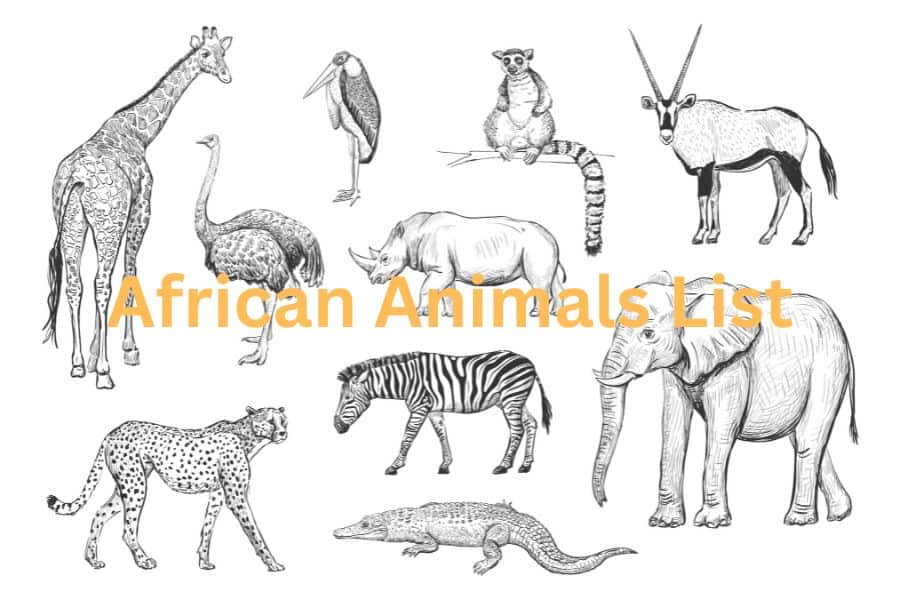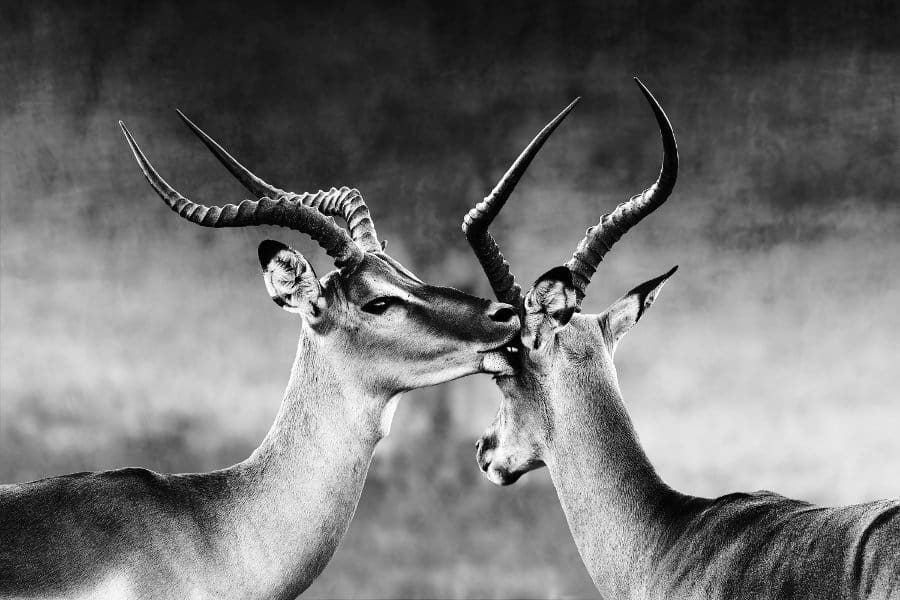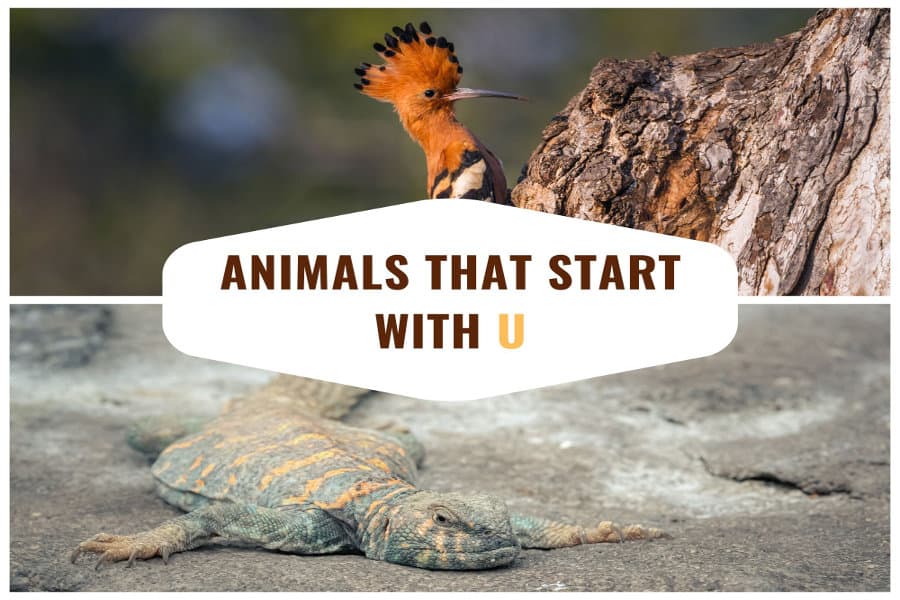African animals are legendary. Lions wandering a dusty savannah. Elephants marching to distant waterholes. Rhinos with proudly defiant horns.
These famous animals are often top of the list for a safari. At Africa Freak, we celebrate the beauty of Africa’s wildlife. From springbok and other African horned animals to predators like the lion and cheetah, there is so much to discover.
Africa is a truly remarkable destination. In this African animal list, you will learn all about the many different species found here, as well as where to see them on safari.
Table of Contents
African Animals With Horns – Antelope & More
Antelope and other horned animals are the most abundant type of animals in Africa. They occupy virtually every African park and reserve.
On a safari, you will come across many different species in the same place, often in the same panorama.
These African animals are hardy. They have adapted to different environments. Some antelope are incredibly fast, having evolved to evade certain predators.
However, watching a predator chase an antelope is a common occurrence, and you can often see this on an African safari.
Visit Africa for the first time and you will see many different antelope and gazelle-like animals.
While exploring the continent’s beautiful landscapes, you will learn to identify different horned African animals. This includes some of the most elegant African antelope species like the bongo, nyala, kudu, and Thomson’s gazelle.
You will also learn to identify some of the largest antelope in Africa, as well as some of the smallest antelope species. While you’ll certainly learn a lot on a safari, let’s get a head start with a list of horned animals in Africa.
Bongo
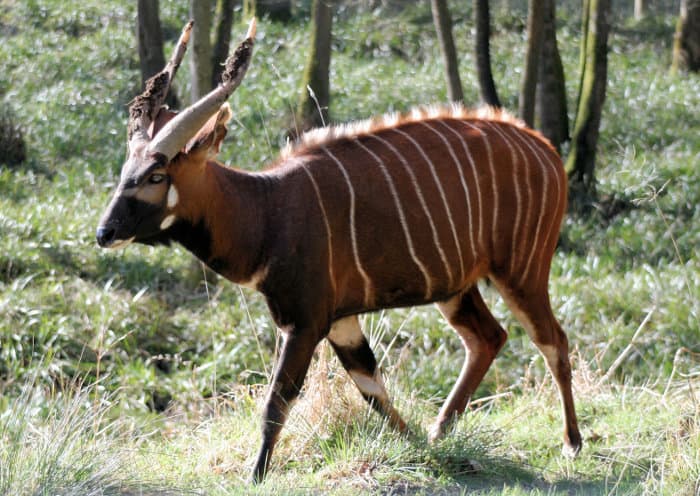
The most striking antelope, bongo, is bright orange with spectacular white stripes.
They are critically endangered, and you can only see them in the forests of Central Kenya and Central Africa.
Bontebok & blesbok

Both these species are medium-sized South African antelope that are near extinction. At one point in history, only 17 bontebok remained in the wild. The rest had been hunted for their fur and tasty meat.
Now there are around 3000, mostly in parks on the country’s coastal fringes. Blesbok are smaller and almost as scarce, with bright white faces that shimmer in the sun.
Bushbuck

Elusive yet widespread across the majority of Sub-Saharan Africa, bushbuck live among the trees. The males are wonderful, displaying sharp spiral horns and charging their predators when hunted.
Unfortunately, such beauty and aggressive behaviour has made this African animal with spiral horns a prime trophy for human hunters.
Dik-dik

Many people think dik-dik to be Africa’s smallest antelope. That title actually goes to the West African royal antelope.
But still, dik-dik are tiny and adorable. Despite being widespread, they are so small it is difficult to see them above the grass. A monogamous antelope, dik-dik, are prey for lizards and birds.
Duiker
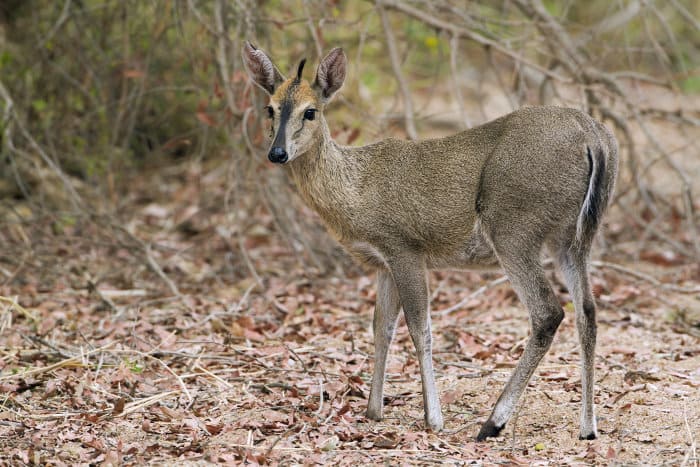
There are 22 different species of duiker, each with strange stubby horns.
You can tell them apart by size and color markings, but it is difficult to see anything other than a common grey duiker on safari.
Eland
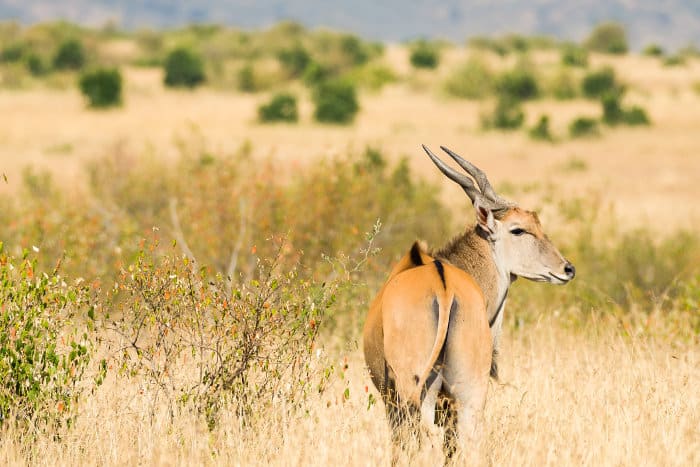
Eland are the largest antelopes in Africa (and the world), yet they are surprisingly bashful and reclusive for their size.
Weighing close to one ton in weight, they are slow and defenseless, except for their size. Walking safaris are a good means of getting close to this African animal with long horns.
Gazelle
Gazelle are small and fast, just like their name evokes.
Thomson’s gazelle are incredibly abundant in Serengeti National Park and the Masai Mara. Hundreds of thousands of them hop about the grasslands.
Sometimes you can see them running away from their nemesis, the cheetah, to avoid being hunted.

Grant’s gazelle are larger and occupy similar spaces, notably in Kenya. Their ringed horns are spectacular, and with each year, these antelope grow an extra ring.
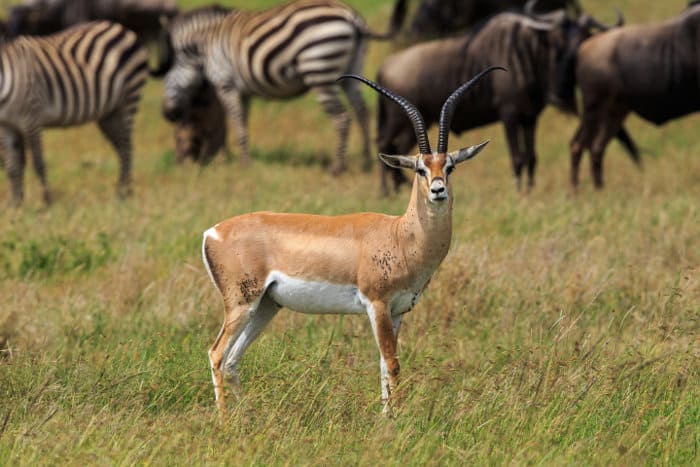
Gemsbok
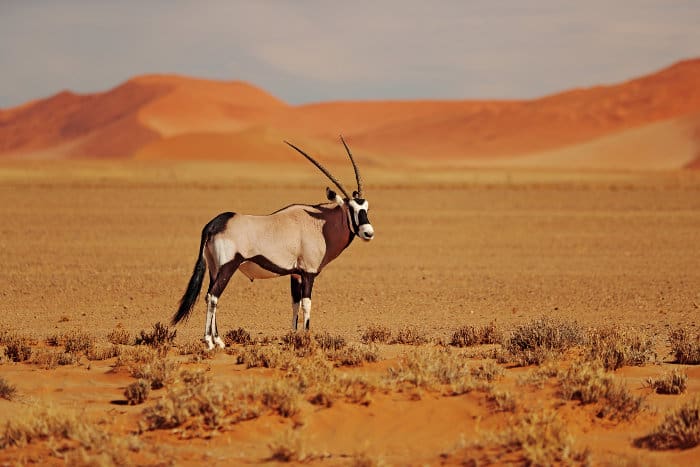
Gemsbok are plentiful in Botswana and Namibia. While their bodies are mundane, their horns are astonishing.
Rising straight and true, gemsbok horns are some of the finest in Africa. Additionally, this long-horned African animal can grow almost a meter in height.
Gerenuk
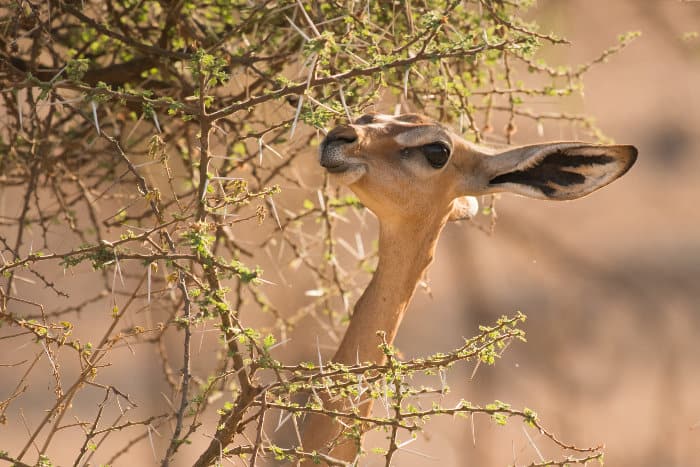
Gerenuk are the giraffes of the antelope world. They have enormous necks. This helps them to eat from tree branches that other antelope find out of reach.
Found in Tanzania and Kenya, they are one of Africa’s most elegant antelope species. Gerenuk have also evolved to live without water. They take all the fluid they need from food.
Hartebeest

Burning amber coats can alert you to hartebeest. This is an enormous antelope scattered all over Southern and East Africa. Males tend to roam on their own and lock horns with male rivals. Females graze in harems.
All hartebeest species are fussy eaters. They prefer the best and lushest grass available. Being picky means they are not very abundant.
Coke’s hartebeest and Lelwel hartebeest occupy East African woodland, while Lichtenstein’s hartebeest occurs across the continent.
Another relatively common antelope in Southern Africa is the red hartebeest, closely related to the tsessebe and the topi.
Impala
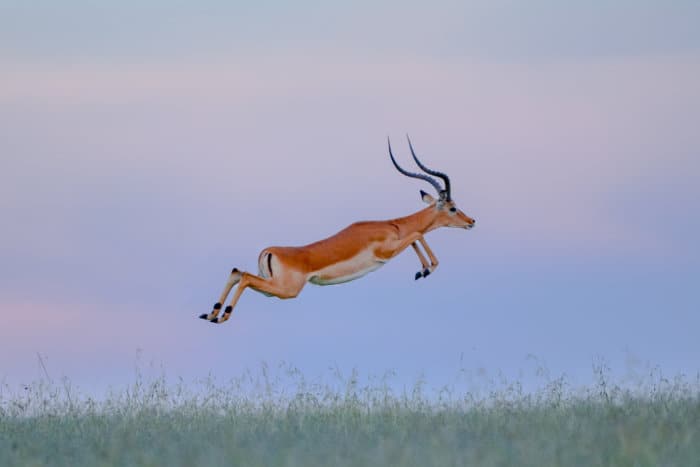
Elegant and agile, impala are slender antelope commonly mistaken for gazelle. If you get confused on safari, remember that impala are a plain sandy color, while gazelle have a black stripe upon their underbelly.
Impala on the run is a spectacular safari sight. You can often see them hopping in zigzags across the grasslands in East and Southern Africa.
Klipspringer
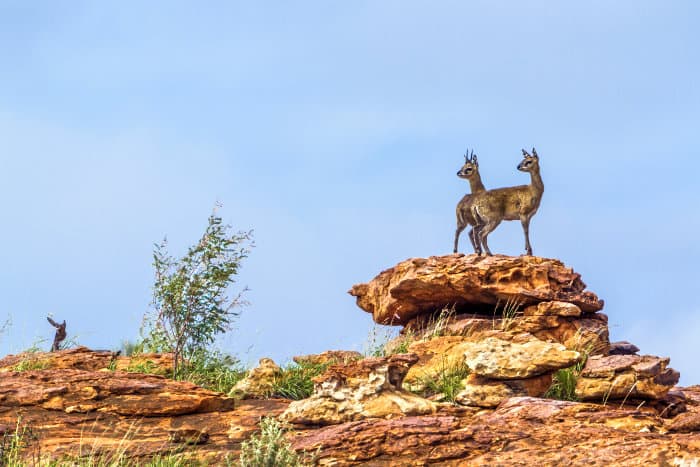
Klipspringers do not need to run from predators. Instead, they are the ultimate rock climbing African animal.
They live on precipitous cliffs and clusters of rock, where they jump around at high speeds.
Kudu
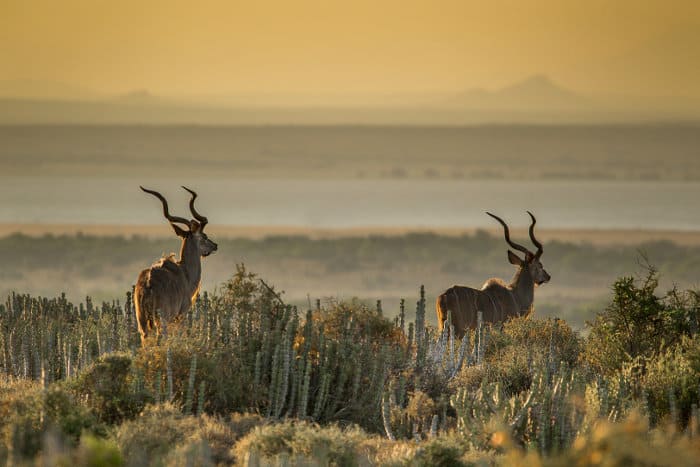
Combine an impressive size with beautiful horns, and it is easy to see why everyone loves the kudu. Jug-like ears only make them more endearing, as do their wispy beards and manes.
Greater kudu are common across the continent, while lesser kudu only occur in East Africa.
Lechwe
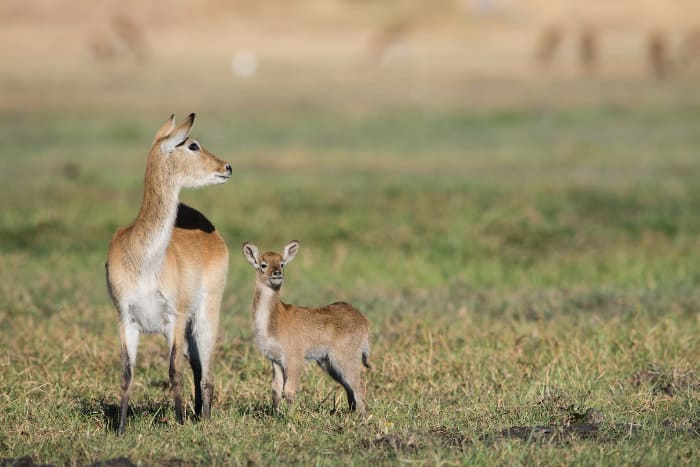
Lechwe looks a lot like Bambi. Slender, agile, cute, and defenseless.
Huge populations live in the swamps and wetlands of Southern Africa, notably in Botswana and Zambia. To escape predators, they run into the water, where most predators don’t like to go.
This African horned animal is a common sight on safaris. You may even spot hundreds of red lechwe splashing about the shallows.
Nyala
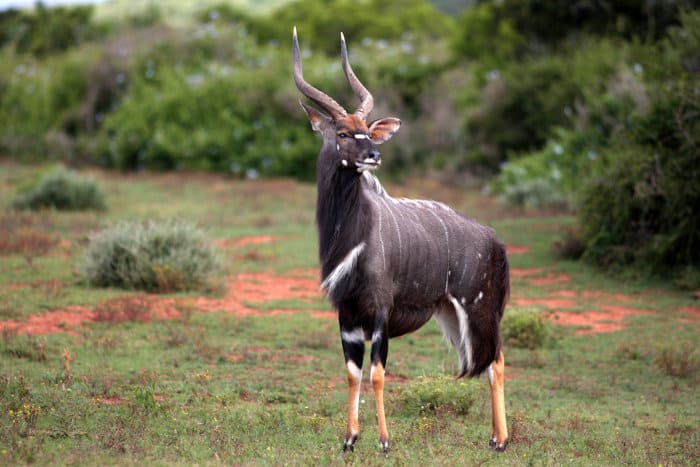
Nyala occur across the north of South Africa and Zimbabwe.
The South African horned animal is often confused with bushbuck. Flowing manes and wispy white decoration make the male bulls one of the continent’s most photogenic antelope.
Oribi
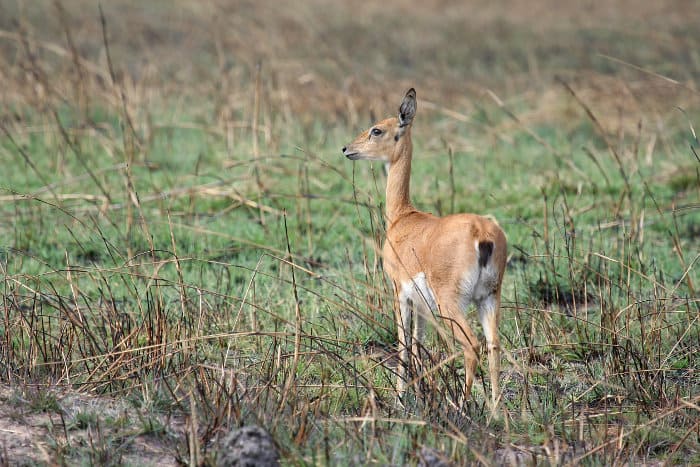
Oribi are a taller version of steenbok, a shy and solitary antelope living in a few parks in eastern, southern, and western Africa.
If you ever glimpse their bushy tails, you will have seen more than some people who have been on a hundred safaris.
Oryx

Beisa oryx are often hunted for their beautiful horns. These spectacular African animals are now endangered and occur only in parts of northern Tanzania and northern Kenya.
Reedbuck

Reedbuck wandered enormous distances across Southern Africa’s arid plains. They are the same color as the desert and can be difficult to see, even on very open landscapes. You will usually spot a small herd dominated by a single male.
Roan antelope
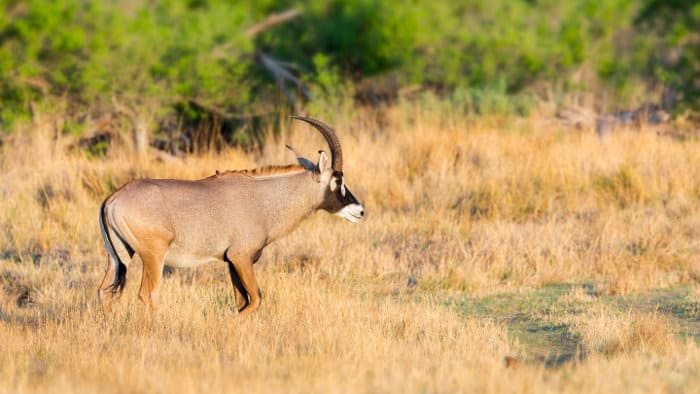
Roan antelope are one of the highlights of a safari in Kruger National Park, South Africa.
These African animals with long horns have black and white faces and stand as tall as most people.
Steenbok
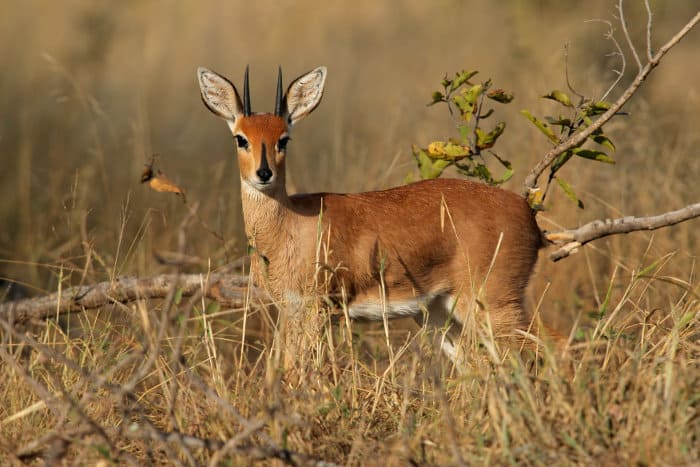
Steenbok are a sight for safari connoisseurs. They are small and orange with squat horns, their appearance easily confused with impala. Steenbok have smaller horns, but the key difference is that this African animal with horns is solitary.
Sable antelope
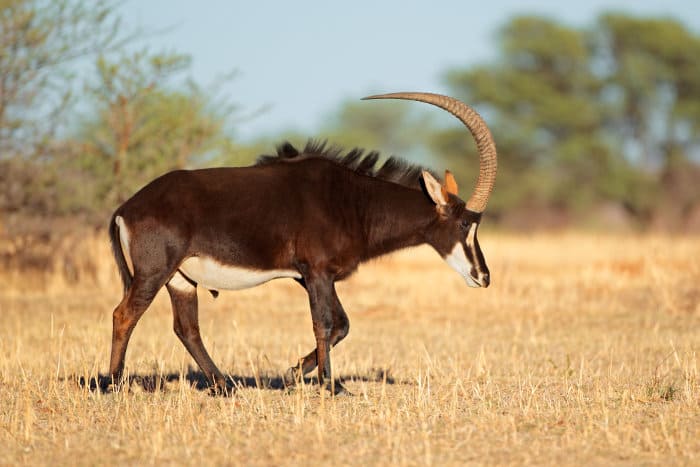
Are sable antelope the most impressive antelope in Africa? Their fur shimmers black and red, and their horns rise straight and proud. Barrel-chested and happy to return a stare, this African animal with curved horns is too big for most predators.
Their numbers are dwindling, notably, because they are premier hunting trophies. Spot them around woodland fringes, most commonly in Southern Africa.
Sitatunga
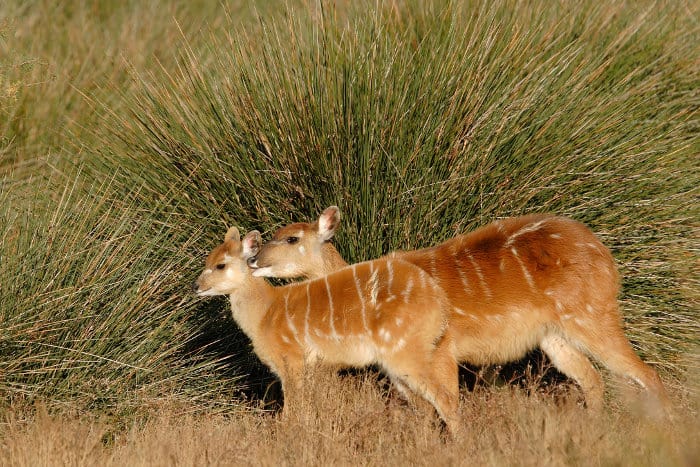
An unusual safari highlight, sitatunga, are aquatic specialists that wade into the water to escape predators.
Botswana is a good place to see them, especially in and around the Okavango Delta.
Springbok
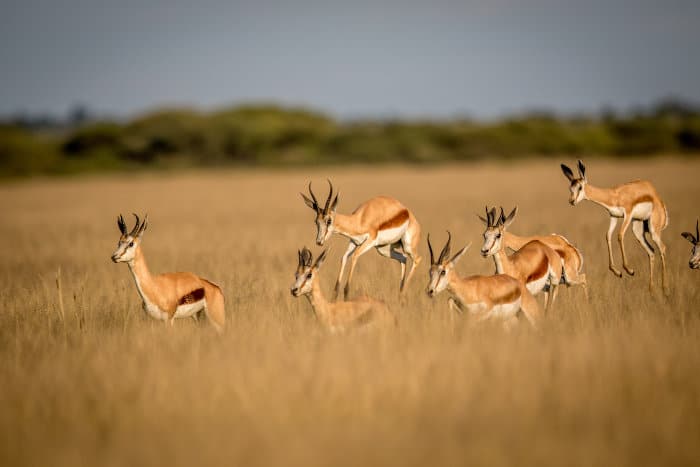
Springboks are a celebrated animal in South Africa, being the country’s national animal and the name of its international rugby team.
Millions of springbok live in South Africa, inside and outside the country’s parks and reserves. You can even see them near Cape Town, at the Cape of Good Hope.
Their most bizarre behavior is pronking. Male springbok jump up and down with straight legs, opening up a special pheromone scent for females to follow.
Suni

Suni are on the tick-list of people who have been on dozens of safari. They are tiny antelope that hide in thick bushes and savannah, with their dull coats proving expert camouflage.
Topi

Large and slow, topi are the enormous antelope you can see in the Serengeti and Masai Mara.
They usually travel in herds of only five individuals but sometimes join the great wildebeest migration. Such a big antelope is always an impressive sight, especially when they are galloping across the grasslands.
Tsessebe
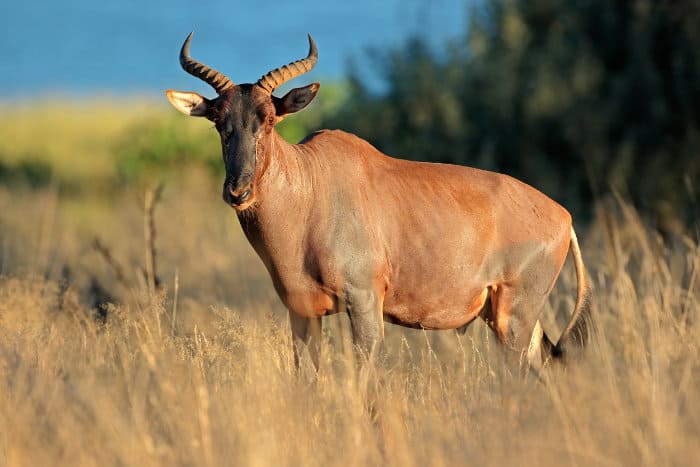
Tsessebe do not have the most stunning appearance. However, these gregarious African animals are still a lovely sight to behold on a safari.
So much interaction occurs within herds, including quarreling males who waltz about in an attempt to impress females.
The Predators
Many of Africa’s most famous animals are predators. They are icons of their environment, symbols of a wild and untouched continent. And there is more than just the big cats.
Lion
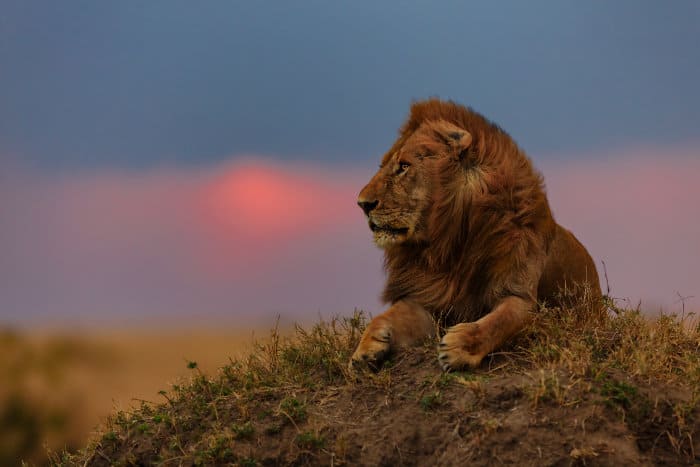
The kings and queens of the savannah (not the jungle as the song suggests), lions are the easiest large predator to see on a safari.
They live in prides and usually occur in the open, all across East and Southern Africa. Lions are not scared of anything. They spend most of their days resting in the shade but will hunt in the cooler hours.
Lionesses do most of the hunting. Then the largest male lion will eat first.
Wondering what sound does a lion make?
Interestingly, these large cats don’t only roar. They also meow, purr, grunt, and moan.
Leopard

Leopards are majestic and radiate mystique. They are solitary and spend their days hiding away, meaning that this African animal can be very difficult to find on safari.
Although widespread across Africa, their secretive nature makes them hard to track.
With their sheer size and incredible speed, leopards are among Africa’s top apex predators. They hunt alone and can take down prey up to ten times their size.
Two iconic scenes take place on safaris. One is of an African leopard resting in a tree, its tail flicking casually. The other is a leopard on the prowl, a dangerous African animal following its quarry.
Bonus: Learn to identify cheetahs and leopards or compare the South American jaguar vs leopard.
Cheetah
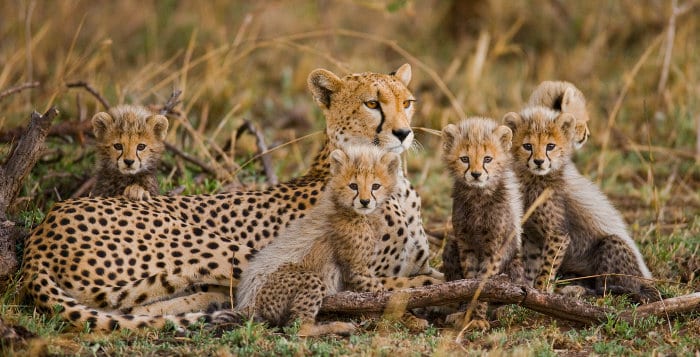
One of the fastest animals in the world is native to Africa but has lost 91% of its historic range over the last two centuries. Only 7000 of them remain, which is an appalling fact.
Cheetahs are also secretive, and they are not hugely strong. While leopards have incredible jaw power, cheetahs trip their prey at high speed. You can learn more about this spotted cat in this article, including how fast a cheetah can run.
King cheetahs are one of the rarest African animals. Estimates suggest that only ten exist in the wild. They are not a different species but have a rare mutated fur pattern, just like black panthers.
Hyena
Three hyena subspecies live in Africa. All three are incredible hunters, even though their reputation precedes them. Hyenas do scavenge, but most of their food comes from hunting.
Most people think of hyenas to be ugly and nasty African animals, a little like Whoopi Goldberg’s character in The Lion King. Yet, they have a surreal beauty when given a chance.
You may think so, but this is also a myth.
Brown hyenas are critically endangered, and just a few thousand of them survive, mostly around the Kalahari.

Spotted hyenas are the most common hyena subspecies. They are widespread across Africa and often move in large clans.
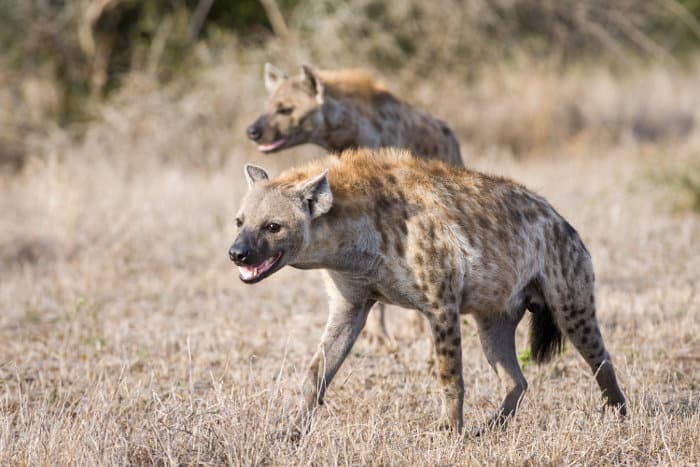
Striped hyenas were once common across Africa and Asia. They regularly come into contact with people and scavenge from garbage bins. Unfortunately, they are also critically endangered.

Wild dog
One of the most spectacular African animals, wild dogs, are ravenous hunters and an ode to yesteryear wildlife.
Unfortunately, they are another animal that is often hunted and near extinction. Additionally, African wild dogs have predators such as crocodiles.
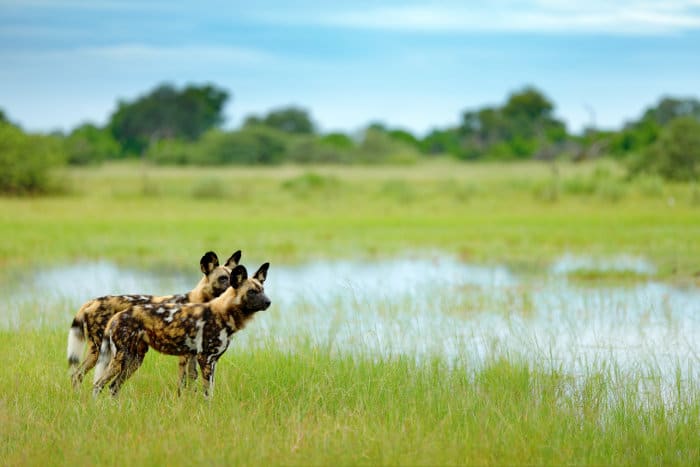
Shabby and wide-eyed, there is a surreal beauty to African wild dogs. They have a few final refuges, such as in northern Botswana and parts of Zambia.
Here is the complete story about why the African wild dog is endangered.
Jackal
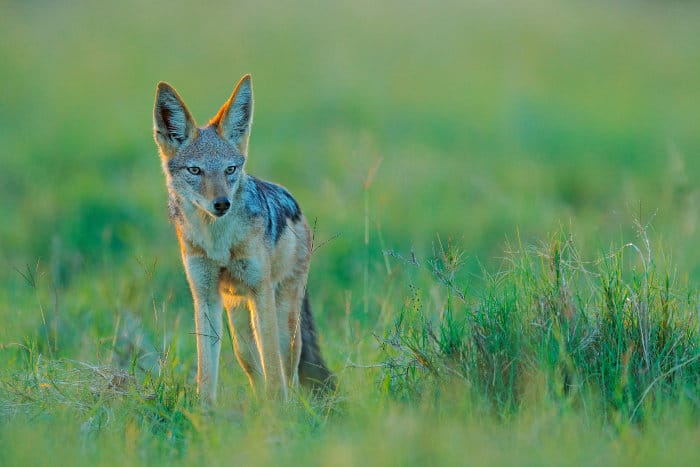
A photogenic canid that is both scavenger and hunter, jackals, are an adorable sight on safari. They are a monogamous African animal that mate for life.
Black-backed and side-striped jackals occur across East and Southern Africa. They are opportunist prey for other predators but will steal food off those same predators.
Smaller cats

A number of smaller cats roam the African savannah. Most of these are nocturnal and spend their days hiding in high grass.
Servals are slender and look a bit like miniature cheetahs. On a nighttime game drive, you should look for their luminescent eyes around a river or waterhole.
Caracals are a nocturnal lynx species with pointed ears and smooth golden fur. While they can hunt gazelle-like springbok, it is very rare to see this African animal out in the open.
On safari, you can also come across animals like the African wildcat.
Small nocturnal predators
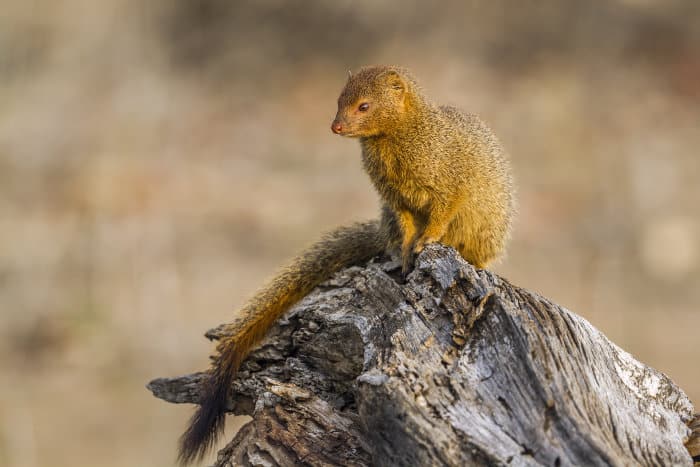
When night falls, a new cast of African animals assembles on the savannah and in the forest.
Some are comically brilliant, such as the mongoose or meerkat. Others move with precision, like the bat-eared fox or furry rock hyrax.
They are both predators and prey. And for the safari connoisseur, these African animals provide some eternal moments and memories.
Large and Iconic Animals in Africa
Most safari reverie is dominated by the largest and most iconic animals. These African animals have come to symbolize a continent. Most are also symbols of a disappearing world as they are critically endangered.
Africa’s large animals are usually much larger than people realize, certainly much bigger than photos suggest. They are also conspicuous and easy to find when you connect with your wild side.
African elephant
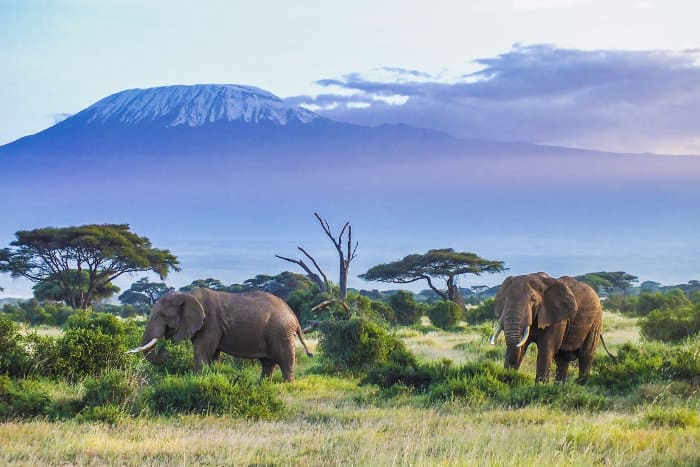
A legend of Africa, elephants, occur in almost all of the continent’s parks and reserves.
Differences occur, such as desert-adapted elephants that travel huge distances across the Kalahari and the big tuskers of South Africa’s Tembe Elephant Park.
It is worth comparing African elephants vs Asian elephants to understand just how big and untamed these giants can be.
One elephant is an incredible sight. A herd of elephants is more impressive. Sometimes you can see hundreds of elephants in the same panorama, such as the more than 100,000 elephants of Chobe National Park.
They are remarkable animals. Read about how fast can elephants run and the incredible sounds that an elephant makes.
Rhino

Rhinos are an emblem of an African safari. Sadly, they are critically endangered and only occur in a small number of parks in national parks in Africa. They are extinct from Botswana and many other countries.
White and black rhinos are both actually grey in appearance. Read here about how fast a rhino can run and also the sounds made by rhinos.
White rhinos are larger and more abundant. They are grazers, while black rhinos have a hooked lip and are browsers.
Up to 20,000 southern white rhinos remain. You can see these large animals on safaris in South Africa, Namibia, and parts of Kenya.
Only two northern white rhinos remain. Yes, two! Unfortunately, these two white rhinos are females, so the species is about to become extinct.
Around 5500 black rhinos have survived, and the majority of these occur in East Africa.
Cape buffalo
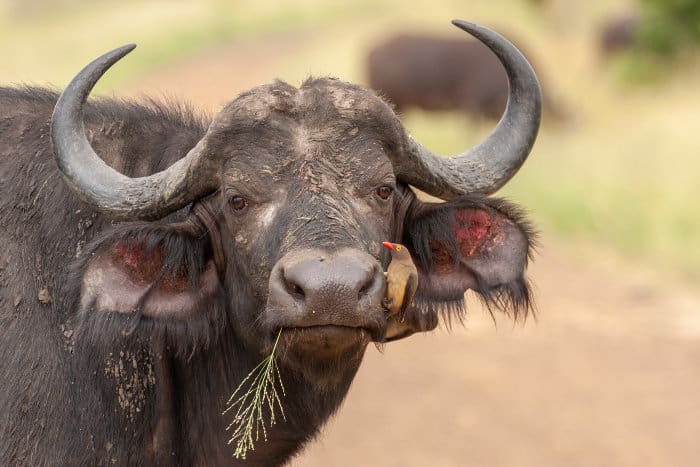
The commonly forgotten fifth member of the big five, Cape buffalo, are aggressive and dangerous. Some may say that these African animals are big unruly burls of fur that chomp and chew all day. But they do have a certain beauty.
Cape buffalo are speedy and noisy animals. You can see them all across East and Southern Africa.
Herds of bachelor males are dangerous and known to charge safari vehicles. However, female family groups are usually sedate so you can get close to them on walking safaris.
Hippo
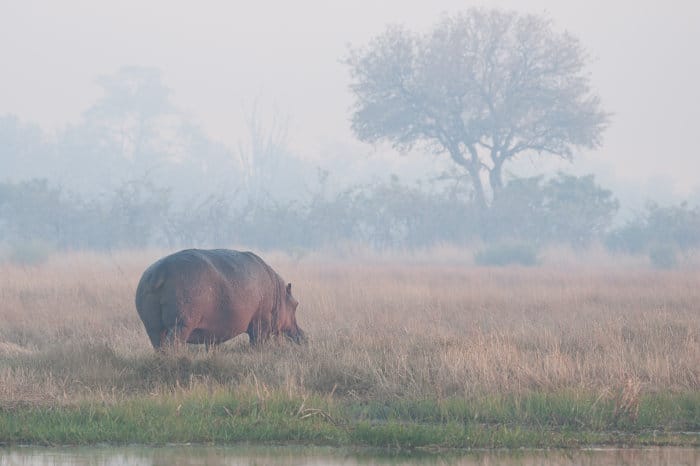
Rumbustious yet famously cute, hippos kill more people than any other large African animal. Never come between a hippo and the water, because you don’t want two tons of bulk charging straight at you.
They spend the day in the water, wading and wallowing, and keeping cool. Then they spend every evening grazing. Dusk is the best time to see them, as they emerge from rivers and waterholes.
Most people know common hippos. They are the giants you can see all across Africa. You might want to read about how fast is a hippo or the sounds a hippo makes.
Pygmy hippos are endangered. They are endemic to parts of West Africa, and as their name suggests, they are smaller than their common hippo cousins.
Giraffe
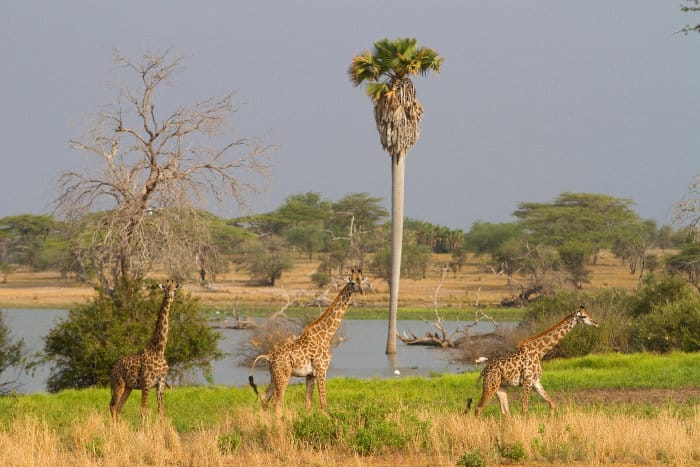
Another iconic African animal is the giraffe. Growing an astounding four to six meters tall, giraffes are easily the tallest land animal in the world.
There are nine distinctive subspecies, defined by their specific markings. None of these subspecies have overlapping ranges, so it is not known if they can mate and produce fertile offspring.
Masai giraffe are the most common, but there are less than 1000 Thornicroft’s giraffe. And while they look big and dopey, just check out how fast a giraffe can run.
Wondering what sound a giraffe makes?
Believe it or not, these animals are incredibly quiet and rarely make a sound apart from the occasional snort or grunt.
Did you know that baby giraffe come into the world by dropping two meters to the ground and landing on their heads?
Find out more fascinating facts about baby giraffes in this article.
More Famous African Animals
On an African safari, there are some animals you simply cannot miss. These African animals are widespread and abundant, so you should see them on nearly every safari.
Zebra

What is it about the uniqueness of zebra stripes? Every zebra has completely distinctive stripes, just like human fingerprints. They make some incredible zebra sounds as well.
They cover Africa’s plains, and when you get close, they have some beautiful details. When they’re not grazing, you may see them moving across the savanna. Did you know, zebra can run at 64 km/h?
Burchell’s zebra, also known as plains zebra, is the most common. They inhabit parks from Southern Ethiopia down to South Africa.
These zebra gather in their hundreds of thousands as part of the great wildebeest migration. Researchers have also uncovered a great zebra migration across the Nxai Pan.
Grevy’s zebra are distinguishable by their tightly packed stripes, but this endangered subspecies occurs only in northern and central Kenya.
Mountain zebra are squat and hardy African animals found on woodland slopes in Namibia and South Africa.
Warthog
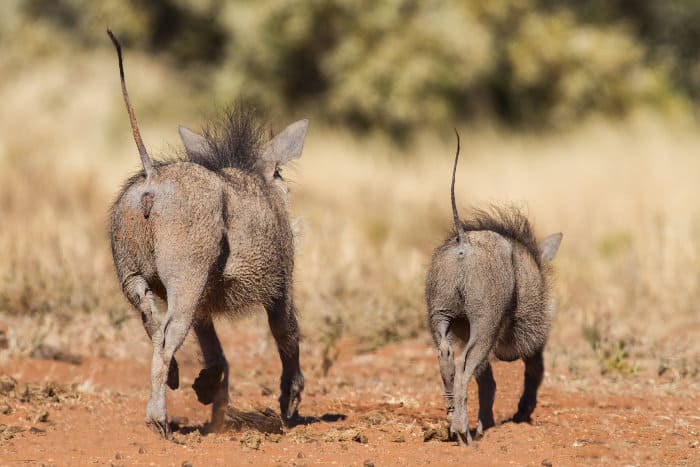
Commonly referred to by their Swahili nickname of Pumbaa, warthogs are curious creatures with pointed tusks and mischievous faces.
They can be easily spooked, found scurrying about the savannah with their tails up in the air. Warthogs are common prey for plenty of predators but they can defend themselves, so don’t get too close to them on a safari.
Bonus: Found the nickname Pumbaa interesting? There are several other animals from the Lion King with names derived from African languages. Check out this article on animal names in Swahili to find out more.
Wildebeest

Wildebeest could have been covered in our ‘list of animals with horns’ section, but they are so iconic they deserve their own place here.
They are one of the world’s most abundant land mammals, and over 1 million of them cover the grasslands of Serengeti National Park and the Masai Mara.
Here is a definitive guide on the great wildebeest migration, including where to go at different times of the year.
Blue wildebeest are more common. They are mid-sized antelope full of energy and charm. You can see them across Sub-Saharan Africa, not just in Tanzania and Kenya.
Black wildebeest are mostly populated in South Africa. They are smaller and shabbier, with distinct white tails.
List of African Animals – The Primates
All primates evolved from Africa, including ourselves. Olduvai Gorge holds the history of humankind and proves that we all came from Africa and share a family tree with other African primates.
There are many other primates in the same family tree. Some are noisy, others are secretive, and the largest are among the most endangered animals on the planet.
While vervet monkeys and baboons occupy the savannah, most primates are residents of the trees. They can be encountered most readily in East Africa’s forests and the Congo Basin.
Gorilla
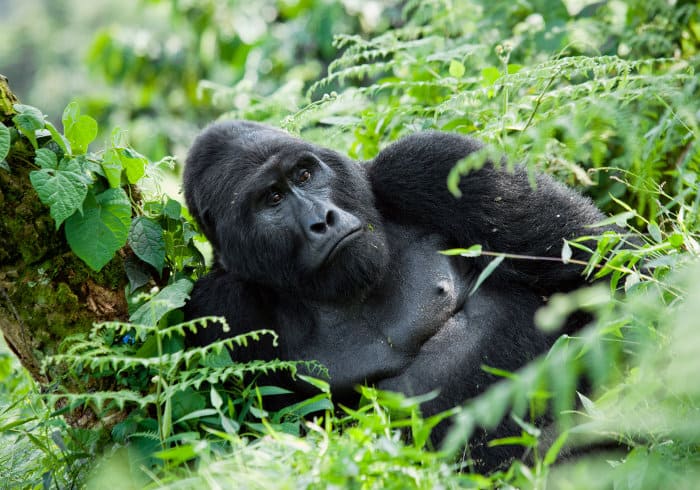
Only around 1000 mountain gorillas remain in the wild. They are the largest of all primates.
This definitive guide to gorilla trekking will show you how to see them in Rwanda and Uganda. This includes where and how to get permits, where to stay, and different trekking locations.
Lowland gorillas are smaller and residents of the Congo Basin. Unfortunately, they are hard to see as the DRC is currently off-bounds.
Gorilla trekking is probably the most dramatic wildlife experience in the world, and gorillas are one of our very favorite African animals.
Chimpanzee

Our closest cousins, chimpanzees, share our ancestry and over 95% of our genes. These African animals offer poignant encounters. Their eyes reveal emotion, and their hands are especially redolent, with fingers so dextrous and similar to our own.
There are two types of chimpanzee encounters. Researchers have habituated chimpanzee troops in the forests of Uganda and Tanzania.
These encounters are almost guaranteed. The troop of chimpanzees you will come across on your trek are relatively accustomed to human contact.
Wilder chimpanzee encounters are also possible. You must trek through dense forests to find troops that may not have seen people before.
Baboon
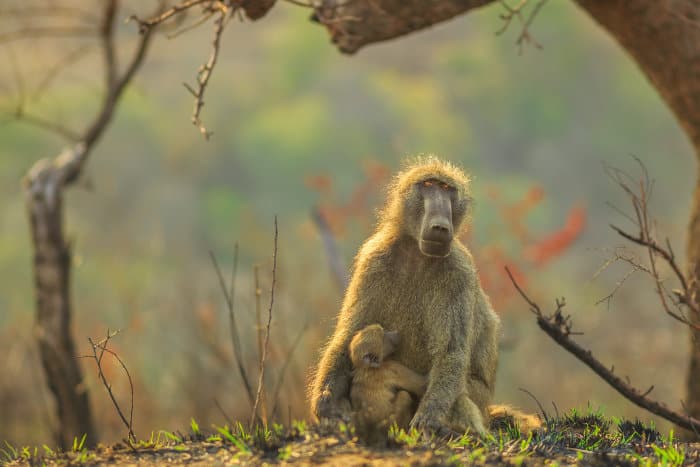
Five baboon species live in Africa. The Guinea baboon is only 50 cm high and weighs just 14 kg. The most commonly encountered of these African animals is the chacma baboon.
Chacma baboons are the largest, and they gather in enormous troops, notably in Lake Manyara National Park.
This is a primate that goes fishing and scavenging through bins. It can open car doors and enter houses, leading to their somewhat unwarranted reputation as criminals.
Monkeys

Another of the most iconic African animals, monkeys, are a common sight on just about every African safari. There are over 200 primate species in Africa, and many of these are monkeys. Some can be seen when you are not on safari.
You can see monkeys on the beach in Kenya, all around Victoria Falls, and even when taking a walk through a city.
Vervet monkeys are the most common and are difficult to miss all over East Africa. Moving in enormous troops, they are daring thieves, cheeky travelers, and full of charm.
Colobus monkeys are more bashful and typically inhabit the higher reaches of a forest.
Black and white colobus monkeys are especially beautiful, with their tails hanging lazily from the top tree branches. Other colobus monkey species include the endemic Zanzibar red colobus.
Many other monkey species exist. Often they are endemic to a particular area, such as a part of the Congo Basin or West Africa.
Mangabeys and macaques
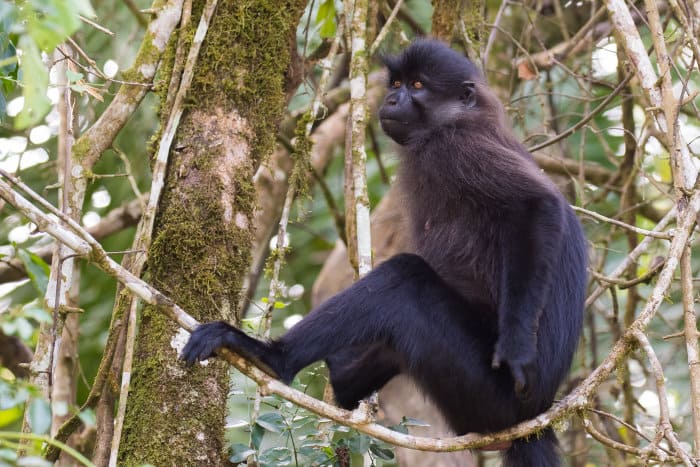
There are certain mangabeys that people have spotted in the last 50 years. These African animals are mostly native to the Congo Basin, and there are many different species.
Like monkeys, mangabeys are highly adapted. They range in size and features but are generally shy and reclusive animals.
Macaques are similar, best experienced on walking safaris through some of Africa’s forested parks, especially those in East Africa.
Bushbaby
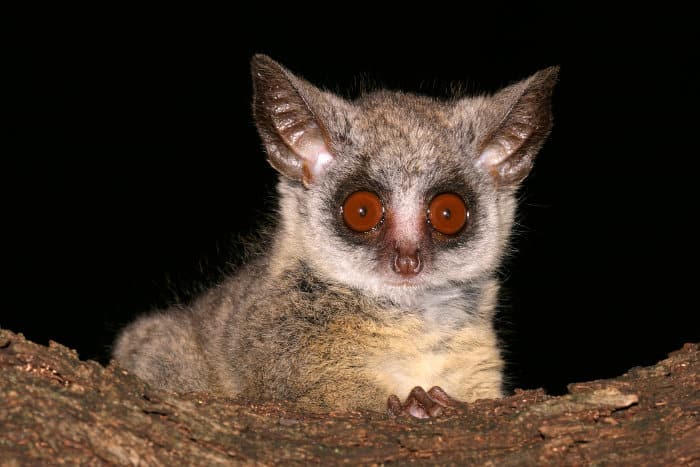
Heard but rarely seen, the bushbaby is the smallest primate species. These African animals have a piercing cry that is often heard echoing through the trees. These are taciturn and nocturnal animals that you will probably only ever see at night.
African Birds

Africa’s birdlife is staggeringly diverse. Most estimates put the total number of species at 2500, representing more than 100 different bird families.
Many of these are endemic. Take South Africa as an example. Over 10% of the planet’s entire bird species live in this single country, from ostriches to yellow-collared lovebirds and crowned eagles to penguins at Boulders Beach.
Explore Africa, and there is an endless variety of bird shapes, sizes, colors, and styles.
You can watch gannets dive for sardines in the Indian Ocean, listen to rowdy marabou storks shouting at jackals, and find lakes painted pink by over a million flamingos.
Famous African birds
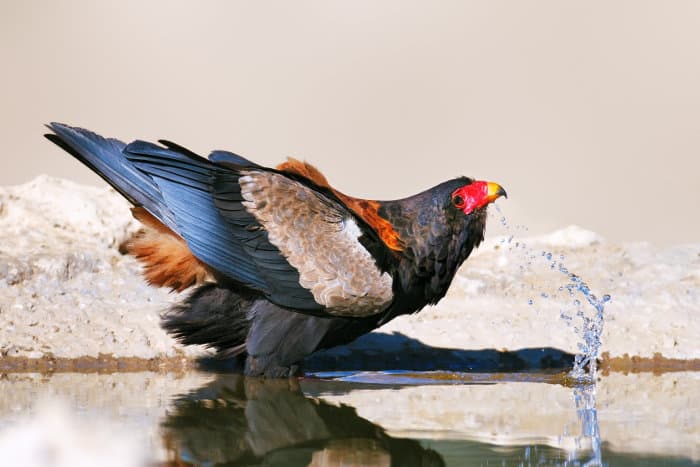
Often it is the birds that tie everything together. African vultures circle, alerting you to a carcass. Yellow-billed oxpeckers sit photogenically upon buffalo, casually removing ticks. Egrets and cranes flutter elegantly past a river.
Eagles are usually the most revered sights. These birds of prey can offer highly dramatic scenes during a safari, especially when they swoop on large quarries hiding in the grass.
The fish eagle is magnificent, a common sighting around lakes populated by hippos and ungulates. Crowned eagles can take down prey up to ten times their weight. Both feature on our guide to the most majestic African eagles.
Shoebills look Jurassic, a dazzling sight from a distant era. They are another beautiful yet misunderstood bird. Many people fear shoebills, yet stories of them eating babies are just popular myths.
The best places to see birds in Africa

Every country in Africa is home to a stunning assortment of birds. Experiencing many of these birds requires a good guide.
For a dedicated bird safari, the first question should be who do you go with, as you will need a specialist to seek out the rarer of these African animals.
You can mix birdlife with big game, or go on dedicated birdlife safaris. Botswana is a popular spot. Uganda has an incredible number of endemic species, and Lake Manyara and Kenya’s forests are wonderful birding destinations.
Wildlife in Africa – Marine Life
People often forget Africa’s marine life. With all the lions, elephants, and many horned mammals, it is easy to neglect the African animals of the water.
To follow are some of the most renowned animals that inhabit the waters surrounding the beautiful continent.
Whales
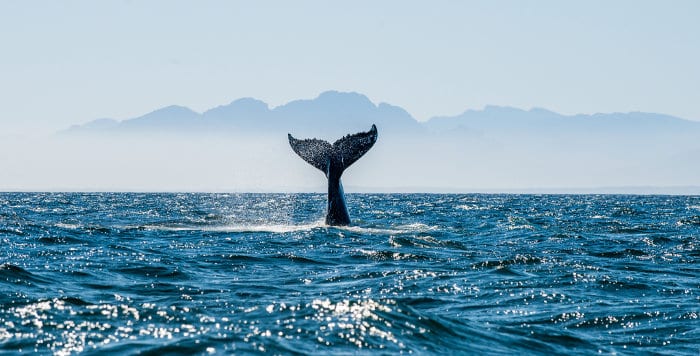
Africa sees more whales than any other continent. They migrate up from Antarctica and pass by on intercontinental migrations.
Hermanus whale watching is arguably the finest in the world as you can see three different whale species directly from the shore.
Humpback whales are a common sight all around South Africa and Mozambique. These giants breach and splash through the water. Bryde’s whales and southern right whales are also resident for half the year.
Whales are harder to encounter off the coast of East Africa, where warm waters keep the giants at deeper depths.
Dolphins
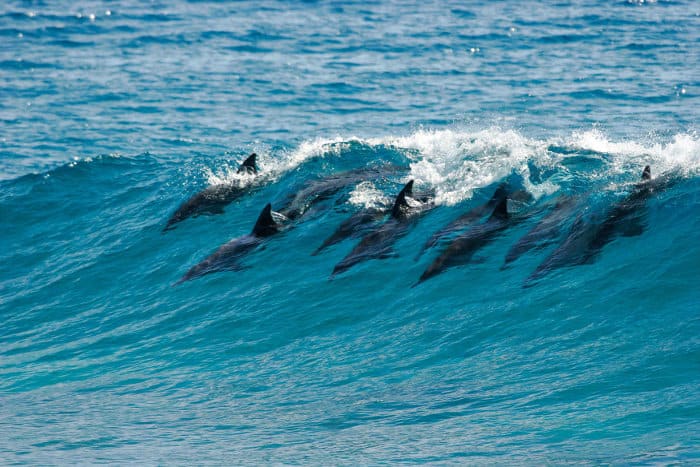
It is hard to imagine an African beach holiday that does not encounter dolphins.
They frolic in Indian Ocean waters all around the continent, from Cape Town to Lamu in northern Kenya. You can also see them in Atlantic Ocean waters on the western half of the continent.
You can see a number of different species, but common dolphins are the most common.
One exceptional experience is to go swimming with dolphins in Kizimkazi on Zanzibar island.
Sharks
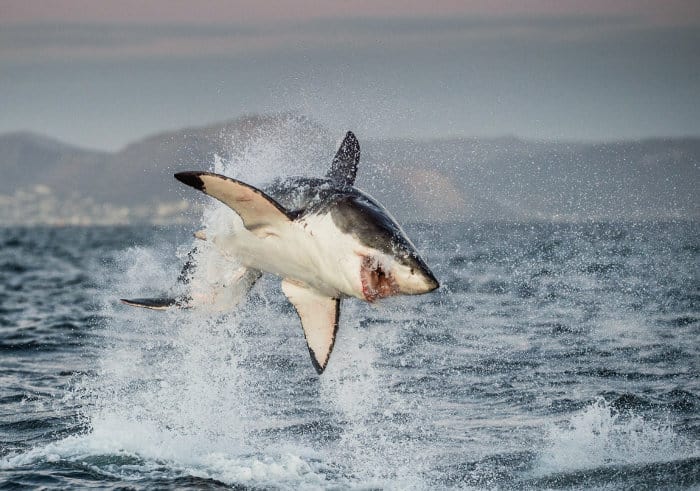
Gansbaai is the great white shark diving capital of the world. Here you can safely go beneath the surface with the ocean’s greatest predator. For more information on this thrilling attraction, check out this Gansbaai visitor’s guide.
Out of all the animals, which do you think is the most dangerous animal in Africa? Is it the great white shark?
Great whites are one of many shark species found in African waters. You will see reef sharks all around the continent, but especially on the eastern coast of Mozambique, Tanzania and Kenya.
Bull sharks patrol river mouths in the Transkei, while leopard sharks frequent Mozambique dive sites. And that is just the start of the African animals you can see in the water.
Spotting African Animals on Safari
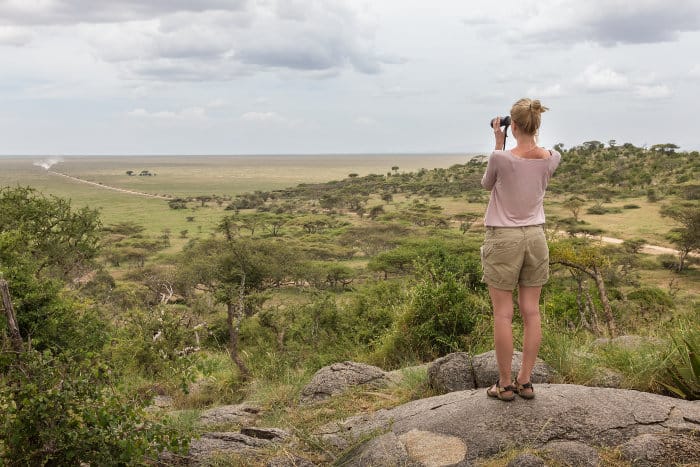
Everybody has their favorite African animals. These are the species they absolutely need to see when visiting the continent.
The largest and most famous animals are widespread. These include four of the Big Five – lion, leopard, buffalo, elephant.
The fifth member is the rhino, an animal that is only seen in South Africa, Namibia, and Kenya. In addition, Tanzania has less than 50 rhinos. Zambia has 12-15 rhinos, and you can walk with them as part of an extended stay in Victoria Falls.
Some other animals are conspicuous, such as giraffe and zebra. However, most other animals are not so easy to encounter.
Landscapes and habitats

The large animals in Africa are so successful because they can adapt to different conditions. For example, elephants across Africa display many subtle differences.
Kalahari lions have developed extra stamina, so they can hunt scant prey on very large territories.
Most of the other animals are specialists. They thrive in specific habitats and these unique habitats are not found everywhere.
A classic example is the hippo. Hippos need water to bathe in and grass to graze. You can find hundreds of them in Lake Naivasha or the Okavango Delta but won’t find any in East Africa’s volcanic forests.
When planning a safari, think about your favorite African animals and the habitat where they live. If you want to see cheetahs then you will need to go on a safari in the African grasslands. For chimpanzees, think East African rainforest.
These detailed guides will help you understand the habitats and African animal highlights of each main safari country: Botswana, Kenya, Namibia, South Africa, Tanzania, Uganda, Zambia, Zimbabwe.
A Note on Wild Animals in Africa
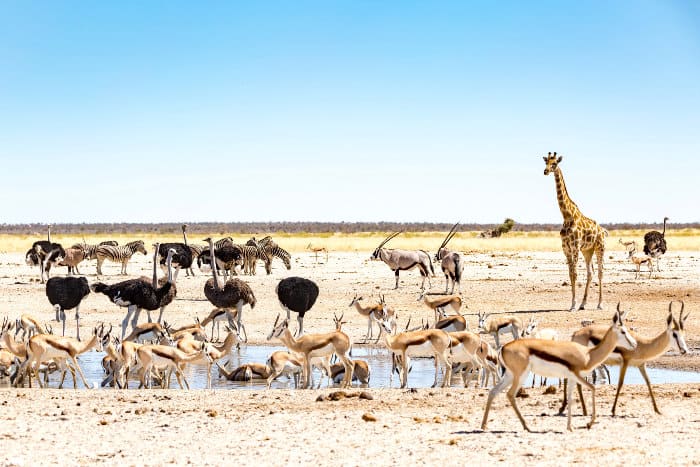
Before heading on a grand safari in Africa, remember that African animals really are wild. Many of these species are not tamed or domesticated.
For example, just compare Indian elephants and Asian buffalo with African elephants and Cape buffalo.
In a zoo, you can see captive animals in a man-made environment. Yet in Africa, you will see wild animals in their natural habitat. These African animals are rarely seen in isolation. They are a product of their daily interactions.
Not only are they wild. They are the very definition of wildlife. You cannot control them. But you can just watch and admire.
Also, remember the incredible diversity of African wildlife. Most people come on safari hoping to see the big five, though in a single national park, you can come across some 100 mammal species!
See African Animals in the Wild
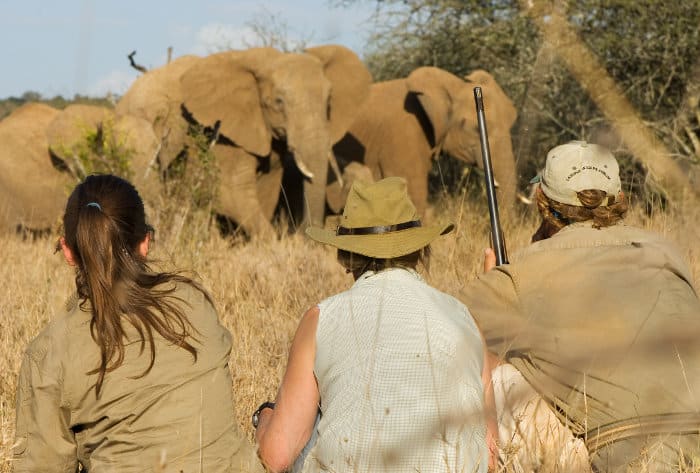
At Africa Freak, we like to connect people with their wild side. And there really is nothing wilder than coming face to face with Africa’s incredible animals.
We have a partnership with a safari specialist who can provide personalized safari planning advice. We also have an incredible array of safari articles you can explore. With good know-how, you can plan your own African safari.
Safari njema!
